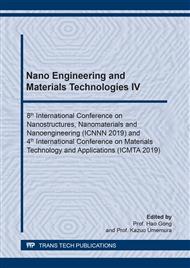[1]
D.S. Ginley, H. Hosono, D.C. Paine, Handbook of Transparent Conductors, Springer, New York, (2010).
Google Scholar
[2]
Ü. Özgür, D. Hofstetter, H. Morkoc, ZnO devices and applications: a review of current status and future prospects, Proc. IEEE 98 (2010) 1255–1268. Vol. 98, No. 7, July 2010. 10.1109/JPROC.2010.2044550.
DOI: 10.1109/jproc.2010.2044550
Google Scholar
[3]
K. Ellmer, A. Bikowski, Intrinsic and extrinsic doping of ZnO and ZnO alloys, J. Phys.D: Appl. Phys. 49 (2016) 413002.
DOI: 10.1088/0022-3727/49/41/413002
Google Scholar
[4]
T. Minami, H. Sato, H. Nanto, S. Takata, Group III impurity doped zinc oxide thin films prepared by RF magnetron sputtering, Jpn. J. Appl. Phys. 24 (1985) p. L781–L784.
DOI: 10.1143/jjap.24.l781
Google Scholar
[5]
Valenti, S. Benedetti, A. di Bona, V. Lollobrigida, A. Perucchi, P. Di Pietro, S.Lupi, S. Valeri, P. Torelli, Electrical, optical, and electronic properties of Al:ZnO films in a wide doping range,J. Appl. Phys. 118 (2015) p.165304.
DOI: 10.1063/1.4934512
Google Scholar
[6]
E. Ochoa-Martínez, E. Navarrete-Astorga, J.R. Ramos-Barrado, M. Gabás, Evolution of Al:ZnO optical response as a function of doping level, Appl. Surf. Sci. 421 (2017) pp.680-686.
DOI: 10.1016/j.apsusc.2016.10.103
Google Scholar
[7]
A. Bikowski, M. Rengachari, M. Nie, N. Wanderka, P. Stender, G. Schmitz, K. Ellmer, Research Update: Inhomogeneous aluminium dopant distribution in magnetron sputtered ZnO:Al thin films and its influence on their electrical properties, Appl. Phys. Lett. Mater. 3 (2015) p.060701.
DOI: 10.1063/1.4922152
Google Scholar
[8]
W. H. Huang, S. J. Sun, J. W. Chiou, H. Chou, T. S. Chan, H.-J. Lin, K. Kumar, J.-H. Guo, Electronic structure of Al-doped ZnO transparent conductive thin films studied by x-ray absorption and emission spectroscopies, J. Appl. Phys. 110 (2011) p.103705.
DOI: 10.1063/1.3662202
Google Scholar
[9]
J. Wang, R. Chen, L. Xiang, S. Komarneni, Synthesis, properties and applications of ZnO nanomaterials with oxygen vacancies: A review, Ceram. Int. 44 (2018) p.7357–7377.
DOI: 10.1016/j.ceramint.2018.02.013
Google Scholar
[10]
Susanta Bera, Moumita Pal, Saswati Sarkar, Sunirmal Jana. Dependence of precursor composition on patterning and morphology of sol–gel soft lithography based zinc zirconium oxide thin films. Applied Surface Science 273 (2013) p.39– 48.
DOI: 10.1016/j.apsusc.2013.01.079
Google Scholar
[11]
B. M. Keyes, L. M. Gedvilas, X. Li and T. J. Coutts, Infrared Spectroscopy of Polycrystalline ZnO and ZnO:N Thin Films,, Journal of Crystal Growth, Vol. 281, No. 2-4, 2005, pp.297-302.
DOI: 10.1016/j.jcrysgro.2005.04.053
Google Scholar
[12]
Davydov A. Molecular spectroscopy of oxide catalyst surfaces. Chichester: John Wiley &Sons Ltd., 2003, p.641.
Google Scholar
[13]
Yamini S. Avadhut, Johannes Weber, Elin Hammarberg, Claus Feldmannb and J. Schmedt. Structural investigation of aluminium doped ZnO nanoparticles by solid-state NMR spectroscopy. Phys. Chem. Chem. Phys., 2012, 14, 11610–11625.
DOI: 10.1039/c2cp41139c
Google Scholar
[14]
Gurpreet Kaurn, AnirbanMitra K.L. Yadav. Pulsed laser deposited Al-doped ZnO thin films for optical applications. Progress in Natural Science: Materials International 25(2015) p.12–21.
DOI: 10.1016/j.pnsc.2015.01.012
Google Scholar


